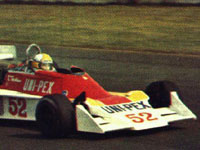Rising sons
Author
- Mattijs Diepraam
Date
- 8W December 1998 issue
Related articles
- Masami Kuwashima - Probably the shortest Grand Prix career ever, by Mattijs Diepraam/Felix Muelas
- Toshio Suzuki - The belated Grand Prix debut of one of Japan's best, by Mattijs Diepraam
Who?Kazuyoshi Hoshino What?Heroes Racing Tyrrell-Cosworth 007 Where?Fuji When?1976 Japanese GP |
 |
Why?
Until the mid-seventies, the Japanese racing scene had been a distant secluded paradise waiting to be discovered by some daring conquistador sailing the Seven Seas in search of new eldorados. When Formula 1 first visited Japan in 1976, its treasures finally came to light.
In its first year at Fuji, the race where Niki Lauda dramatically handed the title to James Hunt, and the following year, the grid was swamped by locals buying their way into regular F1 seats. To give you a run-down of the crop of a fine Japanese generation: we had Masami Kuwashima driving the second Wolf Williams (only to be replaced by Hans Binder) and there was Noritake Takahara replacing Surtees regular Brett Lunger. And what's more: the Japanese seemed to have their own F1 cars and tyres ready on the push of a button. Headlining the F1 samurai were the home-made
Kojima of Masahiro Hasemi, the Maki of Tony Trimmer and this private Bridgestone-shod Tyrrell entered by the crack Heroes team for Kazuyoshi Hoshino.
The two Hs were undoubtedly the stars of that first Japanese GP, Hasemi recording fastest lap thanks to his incredible Dunlop wets, in the end tailing off to finish a lowly 11th after having qualified a superb 10th. After qualifying 21st Hoshino had a similar experience in his Tyrrell, his phenomenal rubber taking him up to third within 10 laps, but eventually he retired when the performance of his Bridgestones lagged off badly in the second part of the race. The supplier of the current World Champion won't like to be remembered about that aspect of its F1 debut...
For 1977, Heroes took over the Kojima operation and its tyre supplier and entered its home Grand Prix again, while its ancient Tyrrell was sold to Meiritsu. This team drafted in Kunimitsu Takahashi, who later became the owner of the very successful Alpha sportscar team that won the Japanese Sports-Prototype Championship three times on the trot between 1985 and 1987, and again in 1989.
Together with Takahara, Hoshino signed up with Kojima. In the new KE009, he lined up a promising 11th on the grid but could not emulate that position during the race. After the second Fuji race Japanese motorsport went back into exile again, having to wait another ten years before F1 returned to the land of the Rising Sun.
This left the Hoshino/Hasemi generation to expand on their national careers, the world forgetting about them until Japan became an economic world force in the mid-eighties. But by then their youthly exuberance had gone and they had to content themselves being looked upon as the steadfast veterans the Japanese factories could rely on in their Le Mans attacks.
His two World Championship appearances set aside, Kazuyoshi Hoshino can still easily claim to be the most successful Japanese driver ever, even in comparison to Satoru Nakajima, Aguri Suzuki or Tora Takagi. Kazu's national single-seater record speaks for itself: 1975 and 1977 Formula 2000 champion, 1978 F2 champion and 1987, 1990 and 1993 F3000 champion.
Only when paired with Hasemi in the Nissan sportscar squad, he was allowed to venture abroad. Together the two Hs were highly successful in sportscars and GTs. Their combined appearances, later teaming up with the slightly younger Toshio Suzuki as well, gave them their only opportunity to show their skills in international endurance classics, the three of them winning the 1992 Daytona 24 Hours for the NISMO Nissan works team, amongst several other fine
achievements.
